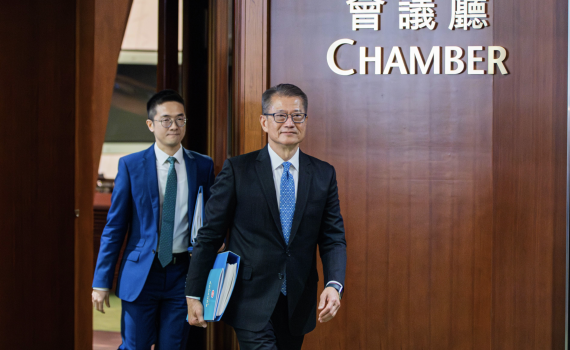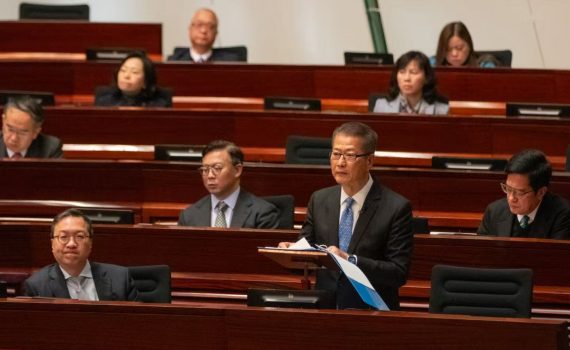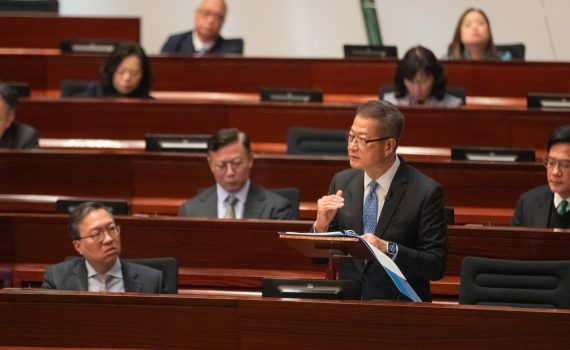Society & Politics
German Election 2025: Tension in central Berlin as election approaches
- 2025-03-01
- Society
- The Young Reporter
- By: Tsz Chiu Ma、LAI Uen LingEdited by: AU YEUNG Jim
- 2025-03-01
Far-right supporters demonstrated against left-wing extremism while antifa supporters called out the rise of fascism in the city centre of Berlin on Feb. 22, one day before Germany’s federal election. One of the right-wing protests was organised by Ferhat Sentürk, the founder and leader of a far-right party, Bürgerliche Allianz Für Deutschland, or Civic Alliance for Germany, formerly a member of Alternative for Germany, or AfD. A group of far-right supporters marched from Dorothea-Schlegel-Platz near Friedrichstraße Station to Berlin Central Station waving the national flag of Germany. Meanwhile, another group of antifa supporters gathered in Schiffbauerdamm to protest against the far-right supporters. Police set up blockades on both sides of the far-right demonstration route to prevent clashes. “If you have a child as a woman, you may not be able to have a legal abortion because some populists and moralists believe that our self-determination does not matter,” said Penelope Alva Frank, a LGBTQ activist, during a speech in the antifa protest. “We have to show that we resist as German people against this far-right propaganda, and this far-right movement is against human rights,” said Marianna, a Green party and antifa supporter who did not disclose her surname because of privacy concerns. Despite police interventions, some antifa supporters managed to block far-right protesters on Hannoversche Strasse for about an hour. The Young Reporter reached out to a number of far-right supporters during their demonstration, but they claimed they do not speak English. The far-right AfD gained widespread support in states that were formerly part of East Germany and nearly doubled their seats to 152 in the Bundestag, according to the Federal Returning Officer. The Christian Democratic Union and Christian Social Union in Bavaria, a centre-right alliance, won 208 seats and became the dominant force in the Bundestag. The incumbent governing coalition, …
German Election 2025: Right-wing parties take over parliament with record high turnout
- 2025-02-27
- Society
- The Young Reporter
- By: LAI Uen Ling、Tsz Chiu MaEdited by: AU YEUNG Jim
- 2025-02-27
Germany shifts to the right after reaching a voter turnout of 82.5% in the 2025 federal election, a record high since the unification of Germany. On Sunday, voters elected a new Bundestag, the lower house of parliament. The Christian Democratic Union of Germany and the Christian Social Union in Bavaria, commonly known as CDU/CSU, a centre-right political alliance, top the election result taking 208 seats with 28.5% of the votes. The far-right nationalist party, Alternative for Germany, or AfD, comes in second with a record 20.8% votes. It now holds 152 seats, according to The Federal Returning Officer. Friedrich Merz, the chancellor candidate of CDU/CSU, is set to become Germany's next leader,and will put together a governing coalition. Prior to the election, CDU/CSU was the largest opposition party in the Bundestag. CDU represented the alliance in 15 of the 16 states, while CSU only contested in the southeastern state of Bavaria. Mark Schneider, CEO of a startup company and a member of CDU, said he believes the party can form a strong government that is able to make clear decisions. “Germany is facing a downshift in the economy. We are not in the best moment,” Schneider said. “Europe has a lot of challenges, including the war in Ukraine. But the last three years of the government were very weak.” He said he would prefer not to have a coalition government, but he suggested the CDU should ally with the Free Democratic Party, another centre-right political party. FDP lost all of its current 92 seats with only 4.33% of the votes, and failed to meet the 5% threshold needed for parliamentary representation. CDU/CSU’s election campaign promised a crackdown on immigration and a deregulation of Germany’s ailing economy. The country’s GDP has decreased for two consecutive years, according to the Federal Statistical …
Budget 2025: Hong Kong unveils HK$10 billion drive for AI industry growth
- 2025-02-26
- The Young Reporter
- By: Ruoyu LI、CAO SiyuanEdited by: WANG Ludan
- 2025-02-26
The budget set aside HK$10 billion to establish an innovation and technology industry-oriented fund to channel investment toward the industries of the future. It is part of Financial Secretary Paul Chan Mo-po's strategy to “put AI at the core of developing new quality productive forces.” “The goal is to make Hong Kong an international exchange and cooperation centre for the artificial intelligence industry," Chan told the Legislative Council in his budget speech. Another HK$1 billion will go toward establishing the Hong Kong Artificial Intelligence Research and Development Centre, which will come under a new Digital Policy Office that will focus on research and development. “The Hong Kong Artificial Intelligence Research and Development Centre will contribute to the local AI ecology and provide jobs for Hong Kong AI talents if the plan can be implemented properly," said Wan Renjie, Professor of computer science at Hong Kong Baptist University who is familiar with the AI ecosystem in both Singapore and Hong Kong. Artificial intelligence and data science are listed as one of the three emerging industrial development sectors in Hong Kong, according to the Hong Kong AI Development Research. The report indicates that 41% of Hong Kong enterprises are currently or plan to adopt AI, while 32% have already applied AI across multiple levels, such as marketing and operations. “It is necessary to allocate part of the budget to invest in AI, though the Hong Kong government cannot predict when it will yield returns,” said Wan. “Once Hong Kong has nurtured an impressive, influential and independent AI enterprise, the return will be immeasurable,” he added. Rodas Sun, 24, Chief Technology Officer of aiKnow, a start-up that focuses on providing business AI models to large-scale companies, said many start-ups now rely on government funding, but they are not truly developing AI products with …
Budget 2025: Improved financial connectivity to boost Hong Kong’s role as RMB trading hub
- 2025-02-26
- Politics
- The Young Reporter
- By: CHEN Ziyu、ZHENG XinyiEdited by: CAO Jiawen
- 2025-02-26
Financial Secretary Paul Chan Mo-po has proposed to enhance Hong Kong’s position as a Renminbi trading hub. The People’s Bank of China and the Hong Kong Monetary Authority will start working together to provide “round-the-clock” and “real-time” small-value cross-boundary remittance services for residents of Hong Kong and the mainland as soon as the middle of this year. “The HKMA will launch an RMB Trade Financing Liquidity Facility for banks as a stable source of relatively lower-cost funds to support banks in providing RMB trade finance services to their corporate customers. The new facility has a total size of 100 billion yuan,” Chan said. According to a report from the Society for Worldwide Interbank Financial Telecommunication, the value of RMB payments increased 2.1% compared to December 2024. Hong Kong handled 78.67% of RMB payments excluding the mainland. Inconvenient renminbi remittance service has been problematic for mainland residents and Hongkongers alike. XiXi Chen, 23, is a mainland student at the University of Hong Kong. “The driver pulled me out because I did not have any cash. It is quite embarrassing,” said Chen. “ I am happy that the government will implement the remittance service so that I will not have to wait for payment.” Cory Choi, 22, a Hongkonger who worked at American International Assurance said before COVID-19, shopping and consumption in the mainland was quite inconvenient. “I was accustomed to bringing a lot of cash. When I tried to pay, the shops told me they did not have change for me,” said Choi. “But since last year, I found I could go to the mainland to shop by just bringing my phone and my Home Return Permit. The e-payment methods in Hong Kong can also be used in the mainland,” Choi added. According to WeChat Pay Hong Kong, more than 3.64 …
Budget 2025: Talent admission schemes receive over 430,000 applications
- 2025-02-26
- The Young Reporter
- By: ZHONG Xinyun、CHEN XiyunEdited by: YANG Haicen
- 2025-02-26
Various talent admission schemes have received more than 430,000 applications and approved more than 270,000 by the end of last year, said Financial Secretary Paul Chan Mo-po in the budget address today. “The budget is set to attract international talent and nurture local talent, reinforcing the city’s status as an international hub for high‑calibre talent,” Chan said. So far, 180,000 talents have arrived in Hong Kong since the scheme started two years ago. The budget also said Hong Kong will host the upcoming global talent summit early next year, and the government will introduce a scholarship targeting students from ASEAN and Belt & Road regions. “This equates to 10,000 new arrivals per month,” said Shang Hailong, Member of the Legislative Council and founder of the Top Talent Service Association. He added that because so many talents have arrived, some may have trouble finding jobs at first. Wan Jiachen, 26, settled in Hong Kong two years ago through the Top Talent Pass Scheme after graduating from Columbia University in the United States. It took him a few months to find work. “The house rent is really expensive and the cost of living is actually quite high,” said Wan, who found a job with the Bank of China. “It would be better if the government could arrange more similar accommodation for foreign talents or provide rental subsidies for foreign talents.” “It is hard to provide direct fiscal support for talents like housing welfare,” said Shang. “Because the median wage level of top talents is HK$50,000, which surpasses the requirements of incentives set for assisting local residents.” Non-local students who graduate from five of the city’s universities are also eligible for the top talent visa. Some of these students said it has been difficult to find a job in Hong Kong. “Hong Kong …
Budget 2025: Waste-to-energy scheme and electric taxis in Green City plan
- 2025-02-26
- Society
- The Young Reporter
- By: CHEN Yongru、LIN XiaoyouEdited by: Lok Tung LAU
- 2025-02-26
Hong Kong Financial Secretary Paul Chan Mo-po announced this morning a plan to get rid of Hong Kong’s landfills. “I·PARK1”, the first waste-to-energy facility for treating municipal solid waste, will be commissioned this year. A second major facility, “I·PARK2”, is up for tender. Once completed, “I·PARK2” is expected to treat 6,000 tonnes of municipal solid waste per day. This year's Green City proposals also include fare reduction and recycling, green transformation of public transport, and smart green mass transit systems. To enhance waste reduction from the source, Chan said the government will allocate an additional HK$180 million to increase the number of smart food waste recycling bins and food waste collection facilities in residential buildings across Hong Kong, expand the recycling network, and increase the amount of waste collected. According to the Environmental Protection Department, “I·PARK1” advanced incineration technology, combined with mechanical sorting and recycling facilities to recover resources from municipal mixed waste and convert the generated heat into electricity, reducing pollutant emissions “Hong Kong is in urgent need of facilities such as I·PARK1 and I·PARK2 in order to convert waste into energy,” said Tsou Jin-yeu, the Founding Committee Member of the China Green Building (Hong Kong) Council. Leung Yee-tak, Chairman of the Asian Intelligent Building Association, said construction waste is still a problem. “Ash produced after incineration, including bottom ash and fly ash, needs to be properly disposed of.” Leung said. “At present, there is excess capacity of building materials in the mainland, the demand for furnace bottom ash is not high, and the treatment technology of fly ash is not mature.” “Although the facility is capable of generating electricity, the incineration process can still produce pollutants, so it needs to be strictly controlled,” he said. “Another key point to achieving energy saving is the user. The government should …
Ukrainian journalists defend local voices as war with Russia enters third year
- 2025-02-21
- Society
- The Young Reporter
- By: LAI Uen LingEdited by: AU YEUNG Jim
- 2025-02-21
Ukrainian journalists at the frontline regions of the Russia-Ukraine war shared their challenges in wartime reporting at a seminar at the Danish School of Media and Journalism. Organised by Nordic Journalism Center, a group of Ukrainian journalists were invited to share their experience in operating newsrooms in wartime Ukraine as the war with Russia enters into a third year. Oleksiy Soldatenko, programme director of the Institute for Regional Media and Information of Ukraine, said journalism in Ukraine has been struggling with the lack of funding and human resources. “We have no equipment, we have energy cuts and blackouts, but we understand that we are part of this profession and we need to work within professional standards," Soldatenko said. He added although working with communities in destroyed cities is difficult, some regional newspapers continue to reach readers. “We work for our communities, but sometimes communities are not there,” Soldatenko said. “We have cities and towns that are completely destroyed, like Pahmo, but the newspaper from Pahmo is still working and going, trying to reach their people wherever they are, across Ukraine and in other countries of the world.” Iryna Synik, editor of Stepova Zorya, a local newspaper based in Russian-occupied Petropavlivka in southern Ukraine, relies on online subscriptions to support operations. Synik said there is no room for depression because she and her only colleague have to edit and produce all the news pieces. But she remains motivated to run the 95-year-old local newspaper. "Because we are a local newspaper, we can tell stories that would not appear in the national news," Synik said. Marharyta Halich, editor of regional TV broadcaster Suspilne Zaporizhzhya, said finding interesting stories during wartime is challenging because people are tired of hearing negative news about destruction and casualties. Halich said she constantly feels empty and depressed …
Increasing use of social media for news risks overloading users’ mental well-being
- 2024-12-21
- Society
- The Young Reporter
- By: AU YEUNG Jim、AO Wei Ying VinciEdited by: KONG Tsz Yuen
- 2024-12-21
Conor James Walker, 22, a university student majoring in history and politics, gets his daily news from websites such as the BBC and Al Jazeera. He said the current amount of information online is detrimental to his mental health. “A lot of information online, and it doesn’t matter whether it’s true or not, is mostly quite depressing subjects,” said Walker. “Fear of war, disease, disasters, and how politics rarely has a good story that comes out of it, no matter what country you look at,” he said. “It can take quite a mental toll on any individual,” said Walker. Walker added that he is less likely to read social media news unless it appears on his social media feed. “There’s the thing with social media,” said Walker, “which is anything can be said by anyone, and it turns out there’s a good chance it may not be true.” According to a report from the UK Office of Communications (Ofcom), the country’s telecommunications watchdog, 82% of those aged 16-24 years relied on social media for news, while only 28% of those aged 55 years do so. The report added that of all Britons aged 16 or above, 52% now consider social media their primary news source, whereas 51% still watch news on television via main broadcasters. This means online media has overtaken television as the biggest source of news. The American Psychological Association describes that constant feed of negative news as “media saturation overload.” Online platforms, especially social media, have algorithms that feed users more of the same to drive views and engagement. Bryan Mclaughlin, an associate professor in the College of Media and Communication at Texas Tech University, said that social media access leads to people being constantly caught up on the news. “If you don't have social media, even …
Scotland’s largest trade union body holds 40th anti-racism march in Glasgow
- 2024-12-01
- Society
- By: AU YEUNG JimEdited by: Hanzhi YANG、KONG Tsz Yuen
- 2024-12-01
Scotland’s Trade Union Centre (STUC) held its 40th annual anti-racism march and rally in Glasgow on Saint Andrew’s Day, Scotland's de facto national day. The event called for inclusivity, solidarity with refugees, and rejection of far-right ideologies. This year’s march celebrated the trade union’s 40 years of resilience in combating racism, particularly as immigration and far-right extremism have become pressing issues across Europe, according to the STUC. “Fascism is rising in Europe, and I think it’s important that people stand up against it,” said Caitlin Dransart, 25, a fresh university graduate. “As a white person, having quite a privilege in society, I think I have a responsibility to speak for people who are marginalised.” Founded in 1897, the STUC today represents over 550,000 workers through its 40 affiliated trade unions and 20 trade union councils. According to the union, it is recognised as Scotland's largest civil society organisation. The STUC began the tradition of organising mass anti-racism marches in 1983 when Scotland saw its first major anti-racist counter-protest in Glasgow, the country’s largest city. Gordon Davie, 75, a retired occupational therapist, said racism is still a major concern in the UK, and said if racism is not pushed back, it will lead to civil war and massive violence. “The driving force of racism today is fear, fear that is exploited and built upon by politicians,” said Davie. “Fear comes from people not being able to afford to buy a house and buy their groceries. All these are caused by the economic system, people are deprived, so they look for someone to blame and they blame immigration and refugees.” Davie said the major political parties in the UK are too complacent in addressing racism, and it is helping right-wing populist parties. “If they don’t address the issue much more strongly, then …
Gen Z mainlanders build community for compatriots in Hong Kong
- 2024-10-28
- Society
- The Young Reporter
- By: YANG Haicen、WANG LudanEdited by: Juncong SHUAI
- 2024-10-28
Go down an unassuming stairway on D'Aguilar Street in Lan Kwai Fong and you will be greeted by a pair of heavy Chinese-style doors. Further deep underground, you will face a wall of graffiti with the name of the bar, Bamboo. The owner of this Chinese style bar is Ran Guangwu, 25, a micro-influencer on the mainland's internet. He started the bar with a group of young mainlanders and most of their customers are also from the mainland. "We host different themed events almost every weekend," Ran said. "People come here to relax, It’s like visiting a friend’s house." According to government statistics, the number of mainland students applying for Hong Kong degrees has risen from a maximum of 20% to 40% over one year, and newly enrolled students from mainland China account for 41% of total enrollment universities in Hong Kong in 2023. Meanwhile, a set of key performance indicators shows at least 35, 000 mainland Chinese have entered Hong Kong under the government run talent import scheme since 2023. They can stay in the city for at least 12 months. Ran Guangwu hopes his bar can offer a home away from home for young mainlanders. Ma Xiaoshuai, 20, a mainland student from The City University of Hong Kong, is a client at Bamboo. “Most bars in Hong Kong are either too fancy or too wild, but this one is just right—very down-to-earth,” he said. He has made new friends there who share his background. Shi Zhengqi , 20, grew up in Fujian and moved to Hong Kong with his parents in recent years to restart his high school life. “We’ll be playing lots of table games here that you’d only find on the mainland, such as Miss Card and King’s Game,” he said. Shi said the life pace …










